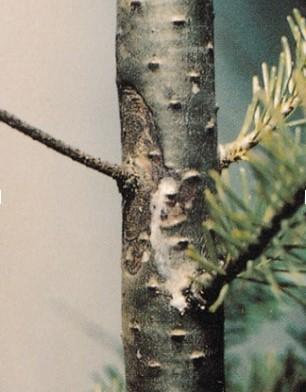Phomopsis Canker of Douglas-fir (Phomopsis lokoyae)
Trees Affected


Common: Douglas-fir
Summary
Phomopsis canker (Phomopsis lokoyae) is a fungal disease that produces cankers on branches and small trees. Phomopsis cankers girdle and kill the tree above the canker. In larger trees, this girdling may cause top death, while smaller trees may be killed outright. Cankers are dark, sunken, and oval-shaped, and are often centered around a dead branchlet. In seedlings, an additional symptom of phomopsis canker is frequently a dead, hook-shaped top, with a sunken, dark patch where the dead material meets the live stem. The fruiting bodies of this fungus appear as tiny black pimples on dead bark near the canker. Although phomopsis canker does not usually cause major damage, the pathogen does enjoy local outbreaks a couple years post-drought, and can cause high cull rates in nurseries due to leader death in seedlings.
Local Distribution
Unknown.
Management Strategies
This fungus does not usually cause widespread damage, but is more likely to do so in extremely wet or dry conditions, or in situations where seedlings are injured or develop fissures from growing too fast. Therefore, in most cases, avoiding over-watering, over-fertilizing, or injuring seedlings will reduce the risk of widespread damage from this pathogen.
Pests and Pathogens with Similar Symptoms
Douglas-fir Engraver Beetle (Scolytus unispinosus) or Douglas-fir Pole Beetle (Pseudohylesinus nebulosus): Top of crown dieback may look similar to that caused by secondary bark beetles such as the two listed here, especially if the damage occurs high up in the canopy. However, dark, oval cankers centered around branchlets will be present around the transition point between live and dead tissue if dieback is caused by phomopsis. Additionally, exit holes and (sometimes) boring material should be present if the symptom is caused by bark beetles.
Further Reading
Basic overview of pathogen and management:
https://www.fs.usda.gov/Internet/FSE_DOCUMENTS/fsbdev2_025890.pdf
Description of symptoms on seedlings and spore identification information:
https://www.fs.usda.gov/Internet/FSE_DOCUMENTS/fsbdev2_025890.pdf
